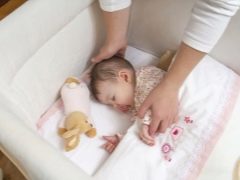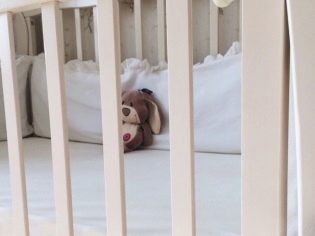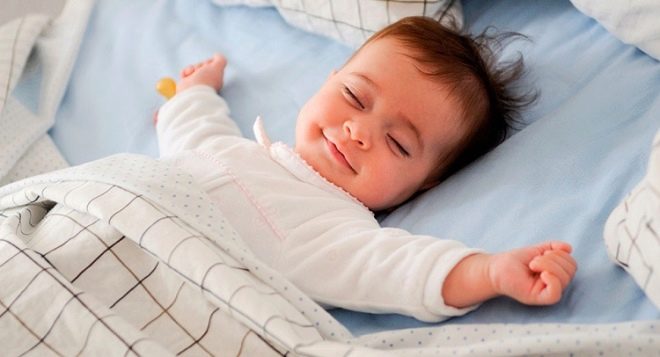Why the child does not want to sleep in his crib and what to do?
A child who does not want to sleep in his crib, which his parents chose with such love, is not uncommon. This situation can occur at any age, and it can be expressed in different ways. But always the problem is far more ambitious than it might seem at first glance. It is worth considering for what reasons the child does not want to sleep in his place, as well as how to teach him to his bed.
The reasons
A child may not want to sleep in his bed for various reasons. First of all, the bed can be uncomfortable. If the baby is physically uncomfortable in the crib, then he will show it with all his appearance. The inconvenience may be due to the following reasons:
- uneven mattress;
- hard or coarse linens;
- violation of the temperature regime - hot in bed;
- the location of the crib in the room - the baby is afraid of something, there is an excess or lack of light, and others.
In addition to physical discomfort, the child can simply show his character. If the child was taught to sleep together, and then quite naturally they are trying to evict him into a separate bed, the protest will be associated solely with psychological discomfort.
The causes of the physiological properties are much easier to eliminate. But the situation when the child does not sleep in the crib "from the principle" can have a rather long flow and will require a lot of patience from the parents.
Allow me to choose a place to sleep?
Some parents calmly perceive the children's abandonment of the crib, since they do not see anything unusual or abnormal in a joint dream. If the child is allowed to choose where to fall asleep, he will surely lie down with his parents. If a newborn is accustomed to sleep in the parent’s bed from the very beginning, it will be rather difficult to retrain it with age. The joint sleep of the child and the parents has its pros and cons.
The advantages are relative convenience. If the baby wakes up in the middle of the night to eat, the mother will not need to get up anywhere - the child will be at hand. Psychologists say that the proximity of the mother to the newborn plays a big role, but, alas, there is no convincing evidence for these theories.
Cons more. And the main one is the inability to quickly wean the child from sleep in the parent's bed. Adults in a dream can inadvertently injure a child, a baby can suffocate (this also happens). Joint sleep does not always comply with the rules of hygiene, and also practically does not give the woman a full sleep, and both parents do not have the opportunity to lead a normal intimate life.
What it can lead to, everyone understands - families break up, couples divorce, children grow up in single-parent families. It would seem that it is just a question of a place of sleep, and what serious and negative consequences may be the wrong answer to this question.
What to do?
First you need to establish what reasons lead to such children's dislike for their own sleeping place. If the baby slept in his crib, but not so long ago began to abandon such a dream, you need to reconsider the issues of convenience. The mattress needs to be bought such that the back of the child does not fall through, rather hard and even. Bed linen and clothes of the baby, in which he sleeps, should be sewn of natural fabrics. You need to choose a soft and pleasant to the touch underwear.
The temperature in the room where the cot is located should be maintained at 21 degrees of heat. Higher temperature can lead to excessive sweating of the baby, to its overheating.And also, before going to bed, you need to ventilate the room - the “stale” air does not contribute to normal sleep and good nighttime sleep. It is advisable to avoid the presence of mirrors in the children's room, as they frighten the child in the dark. And also you should not put a bed in a draft. Cozy space with the use of your favorite baby toys is not so difficult to create.
It is much more difficult to teach a child to the bed after the baby has become accustomed to sleeping together. The decision to evict the child from the parental bed is made once and for all. If mom and dad hesitate, change their decision, then the process of accustoming to the bed will be delayed for a long time and take away from all participants in the process a lot of strength and nerves. It is recommended to put the baby’s bed next to the parent.
For convenience, it is recommended to remove one of the sides of the crib so that at night at any time mom can reach the baby if he starts crying and worrying. But to take the child in his bed, even in this case, it is impossible. He should feel that his mother is relatively close, but under his warm mother's side, he no longer needs to take him.
At this stage, parents will need to clearly see the ultimate goal, to go to it, despite all the protests from the child. And he will definitely protest. At the first stage, it is important to remain calm and persistently stop the child’s attempts to leave his bed and move to his parents. Falling asleep and the woeful cry of a child can take up to several hours. But the child will fall asleep in any case - the physiological need for rest will take its toll.
Gradually, the bed is moved away from the parental bed for a short distance, and the sleep itself will be shorter and shorter. How long training can take is hard to say. It all depends on the child, his character, the perseverance of the parents. One manages to complete the training in a few days, while others take several weeks. A common parental error lies in the emancipations that they suddenly make if the baby suddenly becomes ill, or another tooth begins to painfully cut through. He is immediately taken to himself, back, to calm and ease his condition. After this, you will have to start all over again, but this time reacting to the eviction of the toddler will be even more emotional, the protest will become longer in time.
Opinion of Dr. Komarovsky
Famous pediatrician and TV presenter Yevgeny Komarovsky claims that in a joint dream there is practically no benefit. It is noticeably exaggerated. But if the parents still taught the baby to sleep with them, sooner or later they will definitely face the need to wean him from the parental bed. And also have to teach the child to fall asleep on their own, which is quite a laborious task. According to Komarovsky, on this path they are most likely awaited a violation of children's sleep. The baby may begin to sleep restlessly, often wake up, even if earlier he easily and naturally fell asleep with his parents and slept all night. Sleep is disturbed, which inevitably entails certain changes in the regime. It is best not to allow them, says Komarovsky.
If the baby “fought” half the night for the right to sleep with his mother, and fell asleep in the morning, it is necessary to lift him as usual - at 7 or 8 in the morning. The temptation to leave the baby to sleep will be great, but mom will make a big mistake by allowing you to break the usual way. If you wake the child up, he will be very tired by lunchtime and more likely to fall asleep without motion sickness and other rituals, and in his own bed. If this does not happen, you should try to maintain the regime in the second half of the day. By evening, the peanut will surely be ready to go to sleep on his own.
Especially stubborn and persistent children can harass themselves and others up to three days. After this time, according to Komarovsky, it is usually possible to completely solve the problem of self-falling asleep, if the parents were quite persistent in their decision. Feeding that corresponds to afternoon tea should not be satisfying. A child who is undernourished will get hungry for dinner, and after water procedures, having a full meal, will be able to fall asleep faster. If the baby doesn’t manage to fall asleep, there may be two reasons - either they have overfed him and it is physically hard for him to digest that amount of food, or he is not tired.
Leisure of the child throughout the day should be quite active, including walks, active and active games. Mom should do everything to make the child tired. Then the schooling to go to sleep on your own in your own bed will not be an overwhelming task.
In order to facilitate the task for himself and the child, Komarovsky advises to carry out all daily activities in a rigorous, mandatory manner at the same time.
How to disaccustom a kid from a joint dream, look in the following video from the doctor Komarovsky.





















